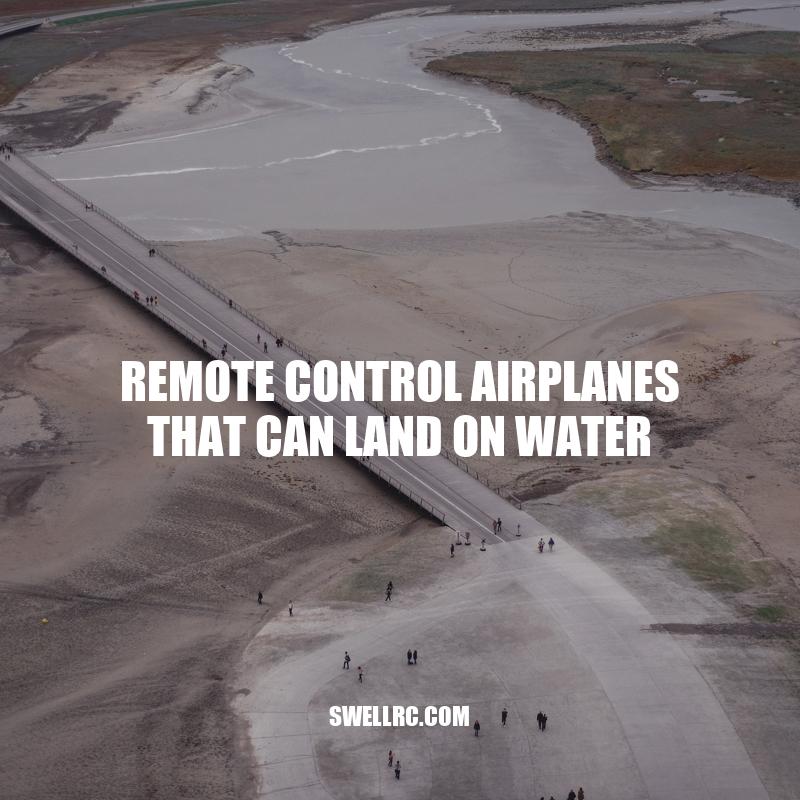Water-Landing Remote Control Airplanes: Advantages, Applications, and Challenges
Remote control airplanes have been popular among enthusiasts and hobbyists for a long time. These miniature airplanes have come a long way from their humble beginnings and can now perform a variety of functions. A recent development in the world of remote control airplanes is the creation of airplanes that can land on water. These airplanes operate on the water surface, and their distinguishing feature is their ability to become buoyant when they land. Remote control airplanes that can float on water are gaining momentum among remote control airplane enthusiasts and water sports enthusiasts alike. They are known by various names, including flying boats, floatplanes, and amphibious airplanes, depending on their design. The development of these airplanes has pushed the boundaries of remote control airplane technology and opened up new possibilities in the field of water-based activities. This article explores the design, construction, applications, advantages, and challenges faced when operating remote control airplanes that can land on water.
Remote control airplanes that can operate on water require specific design and construction. These airplanes are designed to allow the airplane to take off from and land on water. Depending on the design, they may consist of hydrofoils, pontoons, or floats. Let’s take a look at each of these in detail:
- Hydrofoils: Hydrofoils are small wings designed to lift the airplane’s body out of the water, reducing drag, and increasing speed. The wings are usually placed at the bottom of the airplane.
- Pontoons: Pontoons are hollow cylinders that are attached to the airplane’s undercarriage to provide buoyancy when the airplane lands on water. They are usually made of lightweight materials that prevent sinking and allow the airplane to float on the water surface.
- Floats: Floats are similar to pontoons but are less streamlined and attach close to the airplane’s center of gravity, providing stability. They also come in different shapes, such as flat-bottomed or V-shaped, which allow for high-speed landings and takeoffs on the water surface.
Further, remote control airplanes that operate on water are generally made waterproof to prevent damage to electrical components. Some popular models include the Icon A5, Flying Boat F949S, and the AquaCraft El Cajon. Any of these airplanes would provide an excellent entry point for anyone interested in this type of remote control airplane.
How does a remote control airplane work?
A remote control airplane works by using radio control to receive signals from a hand-held transmitter operated by the ground operator. The signals are then communicated to an electronic receiver inside the aircraft, which moves mechanisms that change the plane’s position. This allows the ground operator to control the plane’s movements. For more information, you can visit the Wikipedia page on radio control: https://en.wikipedia.org/wiki/Radio_control. If you’re interested in purchasing a remote control airplane, there are many products available online from retailers such as Amazon or HobbyKing.
Remote control airplanes that operate on water are versatile and can be used in various fields. Here are some of the popular applications of these airplanes:
- Water rescues: Remote control airplanes can be equipped with cameras and sensors to aid in water rescues. They can quickly survey vast water areas and locate stranded individuals in distress.
- Surveying: Remote control airplanes that operate on water can be utilized for seafloor mapping, wind farm surveys, and other sea-based surveys. These airplanes can cover large distances and maintain high levels of accuracy.
- Water-based research: Scientists are also using remote control airplanes to study the oceans and the creatures that live within them. These airplanes can be used to collect important data on animal migration, water temperature, and other oceanic variables.
- Endurance flying competitions: Some remote control airplane enthusiasts enjoy entering endurance flying competitions. These competitions require the airplane to fly continuously for hours on end, and being able to land and take off on water can add to the challenge.
- Remote-controlled sailing: Another popular application of remote control airplanes that land on water is remote-controlled sailing. The airplane can be used to tow a small sailboat, adding an element of fun and competition.
It’s interesting to note that remote control airplanes that can land on water have been around since the 1930s. They were initially used by the military, but have since found their way to mainstream society as a hobby and professional tool. If you’re interested in purchasing a remote control airplane that operates on water, some popular models include the Icon A5, Flying Boat F949S, and the AquaCraft El Cajon.
What are the applications of RC aircraft?
RC aircraft have a wide range of applications that include scientific, government, and military organizations. They are used for experiments, gathering weather readings, aerodynamic modeling, and testing. If you are interested in RC aircraft, you may want to check out websites such as HobbyKing and Horizon Hobby that offer various RC aircraft products.
Advantages of Remote Control Airplanes Operating on Water
Operating remote control airplanes that can land on water has various advantages. Some of the benefits of these airplanes are:
- No need for a runway: Remote control airplanes that land on water don’t require a traditional runway. They can take off from any relatively calm body of water, making them perfect for use in water sports and other outdoor activities.
- Maneuverability: Remote control airplanes designed for water landings have a unique design that makes them highly maneuverable on the water’s surface. The pontoons or floats on the aircraft allow it to turn quickly and navigate tight spaces, inaccessible to conventional watercraft.
- Accessibility: Remote control airplanes that can operate on water can access areas that boats and other watercraft cannot. Their size and design make them ideal for exploring shallow or narrow waterways that larger crafts can’t reach.
- Flexibility: These airplanes are highly flexible and can be customized to suit different needs. They can be built to perform a variety of functions, including mapping, surveillance, photography, and more.
- Cost-effective: Remote control airplanes are generally less expensive than other forms of survey or surveillance technology. They are also much more affordable than conventional planes, making them a practical and cost-effective option for enthusiasts and professionals alike.
It’s worth noting that remote control airplane technology has come a long way in recent years. Today, remote control airplanes that can land on water are equipped with advanced features, including waterproof coatings, GPS systems, and long-range radio transmitters. Popular models include the Amphibious RC Sea Plane and the Flyzone Beaver. It’s essential to fly these airplanes with care and caution and to follow all safety guidelines to prevent accidents and damage to equipment.
What are the advantages of RC planes?
RC planes have several advantages. They are great for recreational purposes and beginners in aero flying. One of the main benefits is that they can help foster creativity and practical skills when constructed at home. Additionally, RC planes are generally cheaper than drones. If you are interested in purchasing an RC plane, there are plenty of websites and products available online.
Challenges of Operating Remote Control Airplanes on Water
While operating remote control airplanes on water can be a fun and thrilling experience, there are several challenges that come with it. Some of the challenges of these airplanes are:
- Water Damage: One of the biggest challenges of operating remote control airplanes on water is the risk of water damage to the electronics and motors. Although most remote control airplanes designed for water landings are waterproof, if the plane crashes or goes under the water, there is a risk of damage to the machinery.
- Securing Pontoon or Floats: It can be challenging to secure the pontoons or floats that keep the airplane afloat in rough waters. Strong waves or currents can easily dislodge the floats or pontoons, leading to uncontrolled movements and potential damage to the airplane.
- Wind and Currents: The weather conditions can also be a challenge for remote control airplanes that operate on water. Wind and water currents can impact the airplane’s flight, making it difficult to control and leading to errors and malfunctions.
- Visibility: Visibility can be a challenge when flying remote control airplanes on water, especially when the sun starts to set. Visibility becomes more challenging when the airplane operates far away from the current location of the pilot.
It is essential for remote control airplane enthusiasts to factor these challenges into their planning and take precautions to mitigate these risks. By taking proper safety measures, including using the proper equipment and technology, planning flights for calm waters, and exercising caution and care, remote control airplane enthusiasts can continue to enjoy this exciting hobby in a safe and responsible manner.
How do you land an RC plane on water?
Landing an RC plane on water can be tricky, but it is definitely doable. One approach is to come in low and slow with minimal descent rate. It is important to maintain enough speed to prevent the plane from stalling and enough altitude to avoid hitting any obstacles underwater. There are many tutorial videos available, such as on the YouTube channel “Flite Test” which has a video on how to successfully land an RC plane on water. It is best to test on calm waters with a floatplane or a plane equipped with floats and to practice in a safe location.
Tips for Operating Remote Control Airplanes on Water
If you are interested in flying remote control airplanes on water, it is essential to follow certain tips to ensure a smooth operation. Some of the tips for operating remote control airplanes on water are:
- Pre-flight Checks: Perform a thorough pre-flight check to ensure the airplane is in good condition before takeoff to minimize the risk of mechanical failure.
- Choose Calm Waters: Plan flights on calm waters to avoid turbulence that may affect the airplane’s control during flight.
- Protective Coatings: Apply the appropriate protective coatings to water-sensitive components to prevent water damage to the electronics and motors.
- Use Waterproof Containers: Keep all the equipment related to the airplane or remote control in waterproof bags or containers during the operation to prevent damage from waves or splashes.
- Be Prepared: Carry extra batteries, spare parts, and other necessary tools to overcome any unexpected situations while flying.
These tips can minimize any risks associated with operating remote control airplanes on water and promote safe and pleasurable flight experiences. For more tips, tricks, and information on remote control airplanes that can land on water, enthusiasts can explore online resources, forums, and communities dedicated to RC flying. One of the popular RC airplane brands that offers floats and seaplanes that can land on water is Horizon Hobby.
What is aircraft design to operate on water called?
Aircraft designed to operate on water are called floatplanes or seaplanes. The terms are often used interchangeably, but technically have different meanings. Floatplanes have one or more floats mounted under the fuselage while seaplanes use their fuselage for buoyancy. Both can take off and land on water and can be used for transportation. For more information, visit wikipedia.org/wiki/Floatplane.
Conclusion
Remote control airplanes that can land on water are an incredible innovation that combines the pleasures of flying and water sports. Though there are several challenges in operating remote control airplanes on water, with proper care and precautions, enthusiasts can achieve incredible feats that are not possible with traditional remote control airplanes. They also offer a unique experience to explore new fields such as water rescues, surveying, research, and competitions. With the increasing popularity of these airplanes, manufacturers are producing them more frequently, and enthusiasts can choose from a wide variety of models with various features and designs. As technology develops further, we can expect to see even more innovation in remote control airplanes. So, if you are interested in flying remote control airplanes and enjoying water sports, then remote control airplanes that can land on water is an excellent choice for you.



